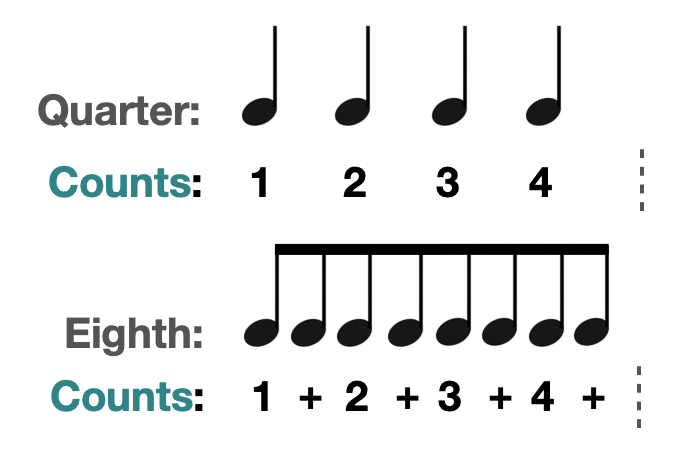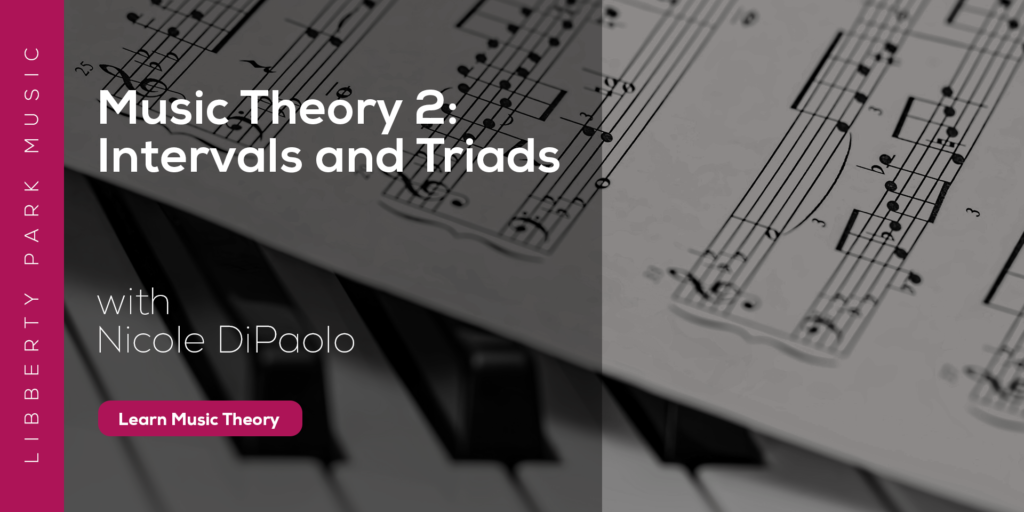
Music needs different kinds of note values to have different kinds of rhythms. Combining a variety of different note values provides a wealth of options for different rhythms, and knowing how to count these different note values is an essential skill for musicians hoping to improve their rhythmic understanding.
Larger note values (such as whole notes, half notes, and quarter notes) can be quite simple to count, while smaller note values (such as 8th notes and 16th notes) can be more challenging, and require a bit more experience.
In this article we’ll give you a short and clear method for counting these smaller note values, and show you how to count different rhythms that incorporate them through notation examples.
Review: What are Note Values?

In the graphic above you can see three of the larger types of note values as they would be counted in a measure with a time signature of 4/4. “Note values” refers to the lengths of notes, which we generally think of in beats or counts.
For example, we think of whole notes as having a note value of four counts, so we hold one whole note for a full, “1-2-3-4” count. Half notes possess two counts, so two of them can fit into the length of a 4/4 measure, each being counted as, “1-2.” Finally, quarter notes come in at 1 count a piece, so we can fit 4 of them into a 4/4 measure, hence, “1-1-1-1.”
You can think of note values as being how we think of notes going from left to right (whereas “pitch” is how we think of notes going up and down).
Counting 8th Notes
8th notes (often seen as “eighth notes” when written) are note values that are smaller than quarter notes. More specifically, 8th notes are half the length of quarter notes, which makes them “half-a-count” in length.

This means that we can fit two 8th notes into the length of one quarter note.
Because 8th notes are smaller than the one count of a quarter note, we need to use some alternative wording to help us count them. To count 8th notes in a quarter note beat we count “1-and,” which represents the counting of two 8th notes: one for the “1” and the other for the “and.” “1-and,” is typically written as “1-+” for ease and efficiency.

As you can see, we get exactly twice as many 8th notes as we do quarter notes when filling a measure 4/4 time. To count this in total while keeping track of the 4 beats, we would count “1-and-2-and-3-and-4-and,” at an evenly spaced tempo.
Counting 16th Notes
Similar to the way 8th notes are half the size of quarter notes, 16th notes are half the size of 8th notes. This means that for every one 8th note we have two 16th notes. Following the math, we end up with four 16th notes fitting into every quarter note count:

Just as with 8th notes, we need to use some new words to help us count 16th notes. Perhaps reflecting the shrinking of the notes values, we shrink our counting-words down to syllables, counting the four 16th notes of a single beat as, “1-ee-and-uh.” 16th notes are generally quite fast, so the way in which we count them needs to be easy to say rapidly (the text below has been colored to make the counts easier to see within the beats).

Music Examples
In this section we'll look at a few short examples to help solidify our understanding.

In the example above you can see a fairly simple and diverse configuration of 8th notes and quarter notes (along with one half note). Throughout these examples, the numbers in color are meant to be counted as part of the sounding rhythm, and the grayed-out numbers are either held through a longer note or part of a rest.
Try to clap and count the passage above. It is written all on one note to help make things easier. In general, you will want to count all of the beats and sub-beats (the "ands" and the "ee's" and "uh's"), but clap only the ones that are heard.
Try to stick to a stable beat that is not too fast (using a metronome to help you is advised), and then count and clap through the exercise. You may need to go through several times to get things right, and to properly absorb the information. You may need to adjust your speed if clapping and counting the 8th notes (or, later, 16th notes) feels too hard. Don't be afraid to slow down, but always try to keep a steady tempo!

Here we have an exercise with 16th notes. Notice that their counts are once again different colors for ease of viewing. They will seem much faster than the notes around them, so choose a slow and steady tempo to start.

In the example above we now have different pitches. The note values here are once again 8th notes, quarter notes, and half notes, so set your tempo accordingly, and remember to focus on the counting and rhythms.

Finally, we have an example including 16th notes with different pitches. 16th notes can definitely make the staff look much busier, so look carefully at what's in each measure! Don't miss the tiny little "uh" in the last part of the first beat of measure 4.
Thanks for checking out this article from Liberty Park Music! If you liked what you saw here, you can find more in our blog at libertyparkmusic.com. We also have a YouTube page! And if you're really ready to take your music training to the next level you can subscribe to our site and gain access to a full spectrum of piano, guitar, drum, and music theory lessons.
Sign up for our free newsletter
Useful articles for musicians
About the Author: West Troiano
West has over 10 years of teaching experience in settings that vary from private studios to college classrooms. In addition to teaching through traditional forms of piano pedagogy, West frequently produces music and teaching materials that cater to the needs of his students. Check out West's course on Piano Etudes for both beginners and intermediate pianists.







